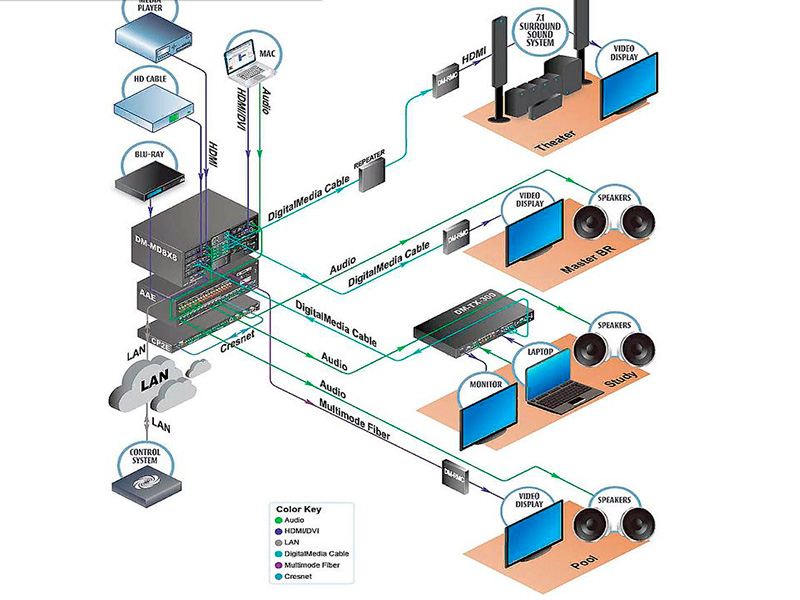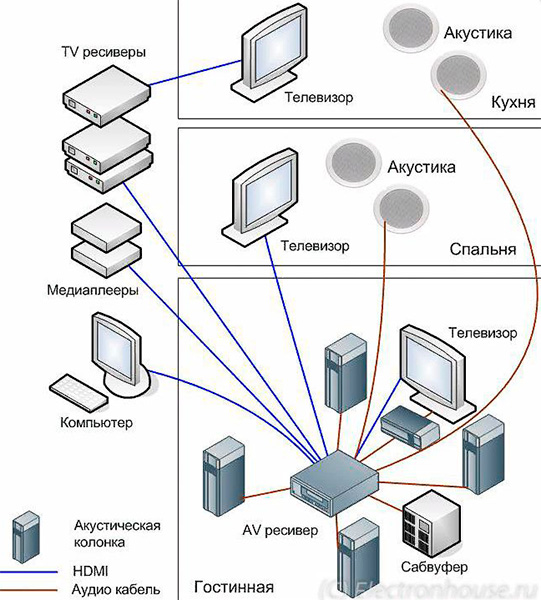What is video multiroom?
The point of building video multi-room systems is to ensure that video content is played in more than one room.
Just putting a few TVs and giving them a signal from a collective antenna is not enough.
Often, in addition to the usual broadcast, satellite TV or IP TV is watched in the house. In this case, the same channel will be shown on all TVs. If you would like to watch different channels on different TVs at the same time, you will need several satellite receivers and a Multiroom service from a satellite provider.
In addition to these sources, there may also be BlueRay players, media players, and computers. There are a lot of devices and not everyone wants to place a rack with equipment at each TV.
The solution to this problem can be to concentrate all signal sources in a special equipment cabinet along with an HDMI switcher matrix that can switch the desired input signal from the selected source to the selected TV. Either only HDMI cables or twisted pair will go to TVs. TVs will need to install a small box - a converter to HDMI interface and control signals.

As shown in the diagram, such a system, in addition to sources, a switch, and terminal equipment (Room Controllers), requires a control system controller. But it can be controlled from anywhere, from any device such as a wall panel, a programmable remote control, from a smartphone or tablet.
Everyone is happy with the solution, except for one thing - the price. In large systems, you can still go for it, and in small ones you can pay about $7000. for a 6x4 matrix (DM-MD6X4) not everyone can afford.
A very small video multiroom can be organized on a receiver of an average or higher price level. They often have an 8X2 HDMI switch (8 inputs, 2 outputs) built into them. At the same time, the cost of such receivers is often close to the cost of an HDMI switch of a similar multiplicity. And in the receiver, in addition to the switch, there is still a lot of useful stuff.

In theory, this design can be controlled from the supplied remote control. But in practice, this is not very convenient. A more universal solution would be to use a program to control such a receiver from a smartphone or tablet via WiFi or connect the receiver to the controller of a normal control system.
In addition to the switching system, you will also need AV signal sources. It can be satellite or IP tuners, and all kinds of media players. Or it will be just separate "boxes" that can play video content available over the network (both local LAN and via the Internet). Or it can be a specialized system consisting of a media server, designed for simultaneous access to it by many client devices, and a set of network media players with support for the ability to work with a media catalog.
The first option is cheap, the second is much more convenient to use, but at least 2 orders of magnitude more expensive (systems like Kaleidascape).

There are also alternative solutions. For example, on a computer or on some network storage systems, you can install a free Plex client-server system or a shell - Kodi player, which can create a media catalog, use separate plugin components to download "covers" for existing films from the Internet movie databases, a list of artists , genre data, etc. But at the same time, the computer equipment and setting up such a player will require significant knowledge in computer technology and time to set up, and the result will most likely still turn out to be less stable than that of a specialized hardware media player. In this case, you will need as many computers as we plan to have video zones. Placing such Kodi players in virtual machines is not considered for cost reasons - it's cheaper to use several inexpensive computers or external streaming players. This solution has one more drawback - in the standard configuration, there will be no synchronization between individual Kodi players.
Conclusions
If building a video multi-room system is a hobby for you, and the main job is a system administrator of a corporate computer network, your solution is Kodi or similar. But it will be necessary to engage in system tuning on a periodic basis.
If you prefer watching movies rather than setting up a system to show them, your solution will be a solution based on one or another "hardware" configuration of players and storage systems. Which one depends on the budget.
Whatever your budget, we can design and build the optimal multi-room system for you within the available amount.
